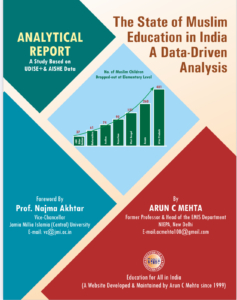
CBSE’s Relaxed Guidelines on APAAR IDs Amid Data Integration Challenges 2025
Introduction
In the pursuit of the National Education Policy (NEP) 2020’s vision for a seamless, technology-driven education system, the Automated Permanent Academic Account Registry (APAAR) stands as a cornerstone initiative under the ‘One Nation, One Student ID’ framework. Launched to create a lifelong, unified academic identity for every learner, APAAR facilitates school mobility, credit transfers, and streamlined verification for higher education and employment opportunities. However, as India’s school education landscape – spanning over 1.47 million schools and serving 233 million students (Classes 1 to 12, as per UDISE+ 2024-25 data) – grapples with the integration of such systems, practical hurdles have emerged. The Central Board of Secondary Education (CBSE)’s recent directive, issued on September 12, 2025, allowing ‘REFUSED’ and ‘NOGEN’ entries for APAAR IDs in the List of Candidates (LOC) for Class 10 and 12 board examinations, marks a pragmatic step forward. This update, analysed through the lens of Samagra Shiksha and UDISE+ frameworks, underscores the need for balanced data-driven reforms that prioritize equity and accessibility. Drawing from Prof. Arun C. Mehta’s ongoing analyses of educational management information systems (EMIS), this note explores the directive’s implications, challenges, and pathways for stakeholders to navigate these changes effectively.
Difficulties Faced by All Concerned
The rollout of APAAR, while ambitious, has intersected with longstanding systemic frictions in India’s education data ecosystem, exacerbating burdens across the board:
- For Principals and School Administrators: Mismatches between school records (e.g., admission registers) and Aadhaar details—often due to transliteration errors in names or dates of birth—create insurmountable barriers. Delays in Unique Identification Authority of India (UIDAI) corrections, which can take weeks or months, force rushed decisions that risk non-compliance with CBSE deadlines. Forcing alterations to match Aadhaar could lead to permanent errors on marksheets, eroding trust in institutional processes.
- For Teachers: As frontline data authenticators under the Student Data Management System (SDMS-UDISE+ 2024-25), educators face the dual pressure of verifying thousands of student records while managing classroom duties. Technical glitches in APAAR portal integration with UDISE+ compound this, leading to incomplete submissions and potential accountability issues.
- For Parents and Students: Parental resistance stems from privacy concerns over Aadhaar linkage, cultural sensitivities around name variations, or simply lack of awareness about APAAR’s benefits. Students, particularly in rural or under-resourced schools, risk exam disruptions if IDs aren’t generated, perpetuating dropout risks (noted at 1.5% at secondary level in UDISE+ 2023-24). This is especially acute for marginalized groups, including Muslim students, where enrollment disparities remain stark (as analysed in Prof. Mehta’s recent UDISE+ reports).
- For Policymakers and Regional Offices: The directive highlights broader EMIS challenges, such as inconsistent data standardization across states under Samagra Shiksha. With Gross Enrolment Ratios (GER) stagnating at 79% for secondary education (UDISE+ 2024-25), delays in universal ID adoption hinder NEP 2020 goals like achieving 100% GER by 2030.
These issues reflect a tension between policy ambition and ground realities, where data silos and infrastructural gaps amplify inequities. Yet, CBSE’s flexibility signals a commitment to adaptive governance, aligning with the data-driven ethos of UDISE+ to foster inclusive progress.
Navigating APAAR Integration for Sustainable Educational Equity
The CBSE’s relaxation in LOC submission protocols is not merely an administrative concession but a strategic pivot in India’s EMIS evolution, echoing lessons from over two decades of DISE/UDISE development. As Prof. Arun C. Mehta’s analyses in Decoding UDISE+ 2021-22 Enrolment Ratios under Samagra Shiksha illustrate, robust data systems must accommodate human and technical variances to avoid exclusionary outcomes. Under the new guidelines:
- ‘REFUSED’ Entries: Where parents explicitly withhold consent – perhaps due to data privacy fears or Aadhaar opt-outs-schools must document this via signed affidavits or consent forms. This entry preserves student eligibility for exams while respecting autonomy, mitigating risks of legal challenges under the Right to Education (RTE) Act, 2009.
- ‘NOGEN’ Entries: For cases where APAAR generation fails despite diligent efforts (e.g., UIDAI delays or portal errors), this code ensures continuity. Schools are advised to log attempts in SDMS-UDISE+ for audit trails, aligning with NEP 2020’s emphasis on digital resilience.
This directive safeguards the 2026 board cycle, preventing the cascade failures seen in early APAAR pilots, where 15-20% of urban schools reported submission delays (preliminary Samagra Shiksha feedback, 2024). For long-term efficacy:
- Recommendations for Principals: Conduct awareness workshops linking APAAR to tangible benefits like seamless higher education admissions. Leverage regional CBSE support for bulk UIDAI corrections, targeting a 90% ID generation rate by mid-2026.
- Guidance for Teachers: Use the SDMS-UDISE+ Teacher’s Guide (2024-25) for batch verifications, prioritizing error-prone records. Integrate APAAR training into in-service programs under Samagra Shiksha to build capacity.
- Advice for Parents and Students: View APAAR as an empowerment tool—track progress via the Diksha app and report discrepancies early to school counsellors. For name/birthdate changes, follow the 2025 UIDAI advisory: Submit supporting documents (e.g., birth certificates) within 30 days for swift rectification.
- Broader Implications: This aligns with Prof. Mehta’s call for “AI-Driven Educational Data Management,” advocating hybrid models where AI automates matching (e.g., fuzzy logic for spelling variants) while human oversight handles edge cases. By 2030, integrating APAAR with UDISE+ could reduce dropout rates by 10-15% through better tracking, but only if equity-focused pilots expand to non-CBSE boards.
Ultimately, this CBSE move exemplifies adaptive policymaking: It tempers NEP 2020’s tech-optimism with empathy, ensuring no child is left behind in the march toward universal schooling. Stakeholders are urged to collaborate-schools with UIDAI, parents with educators – to transform data challenges into opportunities for systemic strengthening.
Frequently Asked Questions (FAQs): CBSE’s Relaxed Guidelines on APAAR IDs
What is APAAR, and why is it mandatory for CBSE board exams? +
APAAR is a unique 12-digit ID linked to Aadhaar, providing a lifelong academic profile under NEP 2020. LOC submission is required to enable seamless data flow, but CBSE now allows exceptions to avoid exam disruptions.
What should schools do if a parent refuses APAAR generation? +
Obtain written consent refusal (e.g., affidavit) and enter ‘REFUSED’ in the LOC. Retain proof for audits to ensure compliance.
How do I handle Aadhaar mismatches like spelling errors? +
Initiate UIDAI corrections via the Aadhaar portal using school-issued documents. If delays persist, use ‘NOGEN’ and escalate to CBSE regional offices for support.
Will ‘REFUSED’ or ‘NOGEN’ affect my child’s exam eligibility or future opportunities? +
No – it’s a temporary measure for timely submission. Students remain eligible, and IDs can be generated later without impacting marksheets.
How does this tie into UDISE+ and Samagra Shiksha? +
APAAR integrates with UDISE+ for real-time enrollment tracking under Samagra Shiksha, aiming to boost GER and reduce dropouts. Schools must update SDMS records accordingly.
What resources are available for name/date of birth changes in APAAR? +
Refer to the 2025 UIDAI Advisory on AAPAR Records. Submit via school portals with proofs; processing typically takes 7-15 days.
How can parents stay informed about APAAR updates? +
Monitor CBSE circulars, Samagra Shiksha portals, or resources like educationforallinindia.com for data-driven analyses and guides.


